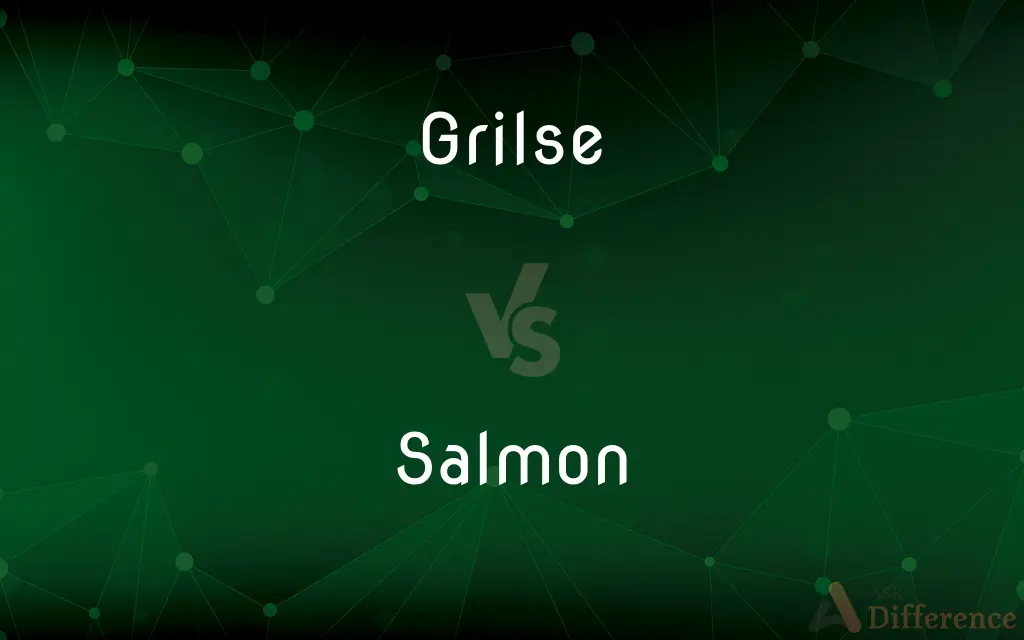Grilse vs. Salmon — What's the Difference?
Edited by Tayyaba Rehman — By Fiza Rafique — Updated on April 1, 2024
Grilse are young Atlantic salmon returning to freshwater to spawn for the first time, while salmon refers to various species, some of which spend years at sea before spawning.

Difference Between Grilse and Salmon
Table of Contents
ADVERTISEMENT
Key Differences
Grilse are typically younger and smaller versions of salmon, making their first spawning migration after one or two years in the ocean. Whereas salmon encompasses a broader category, including several species that may spend up to seven years maturing in the ocean before returning to freshwater to spawn.
Grilse are specifically associated with the Atlantic salmon species, undergoing a single sea-winter before returning to their natal rivers. On the other hand, salmon can refer to both Atlantic and Pacific species, with life cycles that vary significantly among species.
The term grilse is used to distinguish between young salmon making their initial spawning journey and older, larger salmon that have spent more time at sea. Whereas salmon is a general term that can apply to any life stage of the species, regardless of age or size.
While grilse are important for understanding the lifecycle and management of Atlantic salmon stocks, the broader category of salmon is crucial for a wide range of ecological, commercial, and cultural reasons across the globe.
Grilse, due to their smaller size and younger age, may have different survival rates and reproductive success compared to older, larger salmon. On the other hand, the diverse life strategies of salmon, including those that spend multiple years at sea, contribute to the resilience and complexity of salmonid populations.
ADVERTISEMENT
Comparison Chart
Definition
Young Atlantic salmon returning to spawn for the first time.
Various species of fish in the Salmonidae family.
Age
1-2 years in the ocean.
Up to 7 years in the ocean, depending on the species.
Size
Smaller, as they are younger.
Can vary widely; generally larger due to more time at sea.
Spawning Migration
First and only spawning migration.
May spawn multiple times, depending on the species.
Significance
Indicator of recent ocean survival and conditions.
Ecological, commercial, and cultural significance.
Compare with Definitions
Grilse
First spawning migration.
Anglers often target grilse due to their abundance during the early summer months.
Salmon
Culturally and commercially important.
Salmon fishing is a vital industry and cultural practice in many regions.
Grilse
One or two years at sea.
The grilse spent one winter in the North Atlantic before returning to its natal river.
Salmon
Various species.
The Pacific salmon includes species like Chinook and Sockeye.
Grilse
Smaller than mature salmon.
Grilse are distinguishable from older salmon by their size and scale pattern.
Salmon
Ecologically significant.
Salmon are keystone species, supporting wildlife from bears to eagles.
Grilse
Important for stock assessments.
The number of grilse returning to a river is a key metric for fishery managers.
Salmon
Spends years at sea.
Some salmon do not return to spawn until they are several years old.
Grilse
Young Atlantic salmon.
A grilse is often less than 63 cm long upon its return to freshwater.
Salmon
Larger due to longer ocean residency.
Mature salmon can weigh over 30 kg, depending on the species and age.
Grilse
A young Atlantic salmon on its first return from the sea to fresh or brackish waters.
Salmon
Any one of several species of fishes of the genus Salmo and allied genera. The common salmon (Salmo salar) of Northern Europe and Eastern North America, and the California salmon, or quinnat, are the most important species. They are extensively preserved for food. See Quinnat.
Grilse
A young salmon after its first return from the sea.
Salmon
Salmon is the common name for several species of ray-finned fish in the family Salmonidae. Other fish in the same family include trout, char, grayling, and whitefish.
Grilse
A young salmon after its first return from the sea.
Salmon
A large edible fish that is a popular sporting fish, much prized for its pink flesh. Salmon mature in the sea but migrate to freshwater streams to spawn.
Salmon
Any of a number of fishes resembling the salmon.
Salmon
A pale pink colour
Ceanothus-clad walls of salmon brick
Cotton checked throw in cream and salmon pink
Salmon
Any of various large salmonid food and game fishes of the genera Oncorhynchus and Salmo of northern waters, having pink or red flesh and characteristically swimming from salt to fresh water to spawn.
Salmon
The flesh of a salmon, used as food.
Salmon
A yellowish pink to light or reddish orange.
Salmon
One of several species of fish, typically of the Salmoninae subfamily, brownish above with silvery sides and delicate pinkish-orange flesh; they ascend rivers to spawn.
Grilled salmon
Salmon paté
Salmon steak
Salmon
A meal or dish made from this fish.
Salmon
A pale pinkish-orange colour, the colour of cooked salmon.
Salmon
The upper bricks in a kiln which receive the least heat.
Salmon
(Cockney rhyming slang) snout (tobacco; from salmon and trout)
Salmon
Having a pale pinkish-orange colour.
Salmon
To ride a bicycle the wrong way down a one-way street.
Salmon
A reddish yellow or orange color, like the flesh of the salmon.
Salmon
Of a reddish yellow or orange color, like that of the flesh of the salmon.
Salmon
Any of various large food and game fishes of northern waters; usually migrate from salt to fresh water to spawn
Salmon
A tributary of the Snake River in Idaho
Salmon
Flesh of any of various marine or freshwater fish of the family Salmonidae
Common Curiosities
How do grilse differ from salmon?
Grilse are younger, smaller, and on their first spawning migration, while salmon can be older, larger, and may spawn multiple times.
Why is the distinction between grilse and salmon important?
It helps in understanding salmon life cycles, managing fisheries, and conserving stocks.
What is a grilse?
A young Atlantic salmon making its first return to freshwater to spawn.
Can grilse and salmon be found in the same rivers?
Yes, both can be found in the same rivers, often returning to spawn at different times.
Do grilse have the same survival rates as older salmon?
No, their survival rates can be different due to size, experience, and environmental factors.
How long do grilse spend in the ocean?
Typically, one to two years.
Do grilse contribute to the salmon population?
Yes, they are an important part of the reproductive cycle of salmon.
Do grilse eat the same food as salmon?
Yes, their diets are similar but may vary based on their size and oceanic phase.
Are grilse only found in the Atlantic Ocean?
Yes, the term specifically refers to young Atlantic salmon.
Are all young salmon called grilse?
No, only young Atlantic salmon on their first spawning migration are called grilse.
Why are grilse important for stock assessments?
Their numbers provide insights into ocean survival and future spawning populations.
How are grilse managed in fisheries?
They are managed through quotas, seasonal restrictions, and conservation measures.
What makes grilse significant to anglers?
Their abundance and predictability during certain seasons make them popular targets.
What challenges do grilse face?
They face similar challenges as other salmon, including habitat loss, predation, and climate change.
Is the size of a grilse a good indicator of its age?
Yes, size can indicate their age and the time they have spent in the ocean.
Share Your Discovery

Previous Comparison
Confident vs. Unconfident
Next Comparison
Liniment vs. LotionAuthor Spotlight
Written by
Fiza RafiqueFiza Rafique is a skilled content writer at AskDifference.com, where she meticulously refines and enhances written pieces. Drawing from her vast editorial expertise, Fiza ensures clarity, accuracy, and precision in every article. Passionate about language, she continually seeks to elevate the quality of content for readers worldwide.
Edited by
Tayyaba RehmanTayyaba Rehman is a distinguished writer, currently serving as a primary contributor to askdifference.com. As a researcher in semantics and etymology, Tayyaba's passion for the complexity of languages and their distinctions has found a perfect home on the platform. Tayyaba delves into the intricacies of language, distinguishing between commonly confused words and phrases, thereby providing clarity for readers worldwide.
















































